warning light INFINITI EX 2011 Owners Manual
[x] Cancel search | Manufacturer: INFINITI, Model Year: 2011, Model line: EX, Model: INFINITI EX 2011Pages: 480, PDF Size: 4.04 MB
Page 374 of 480
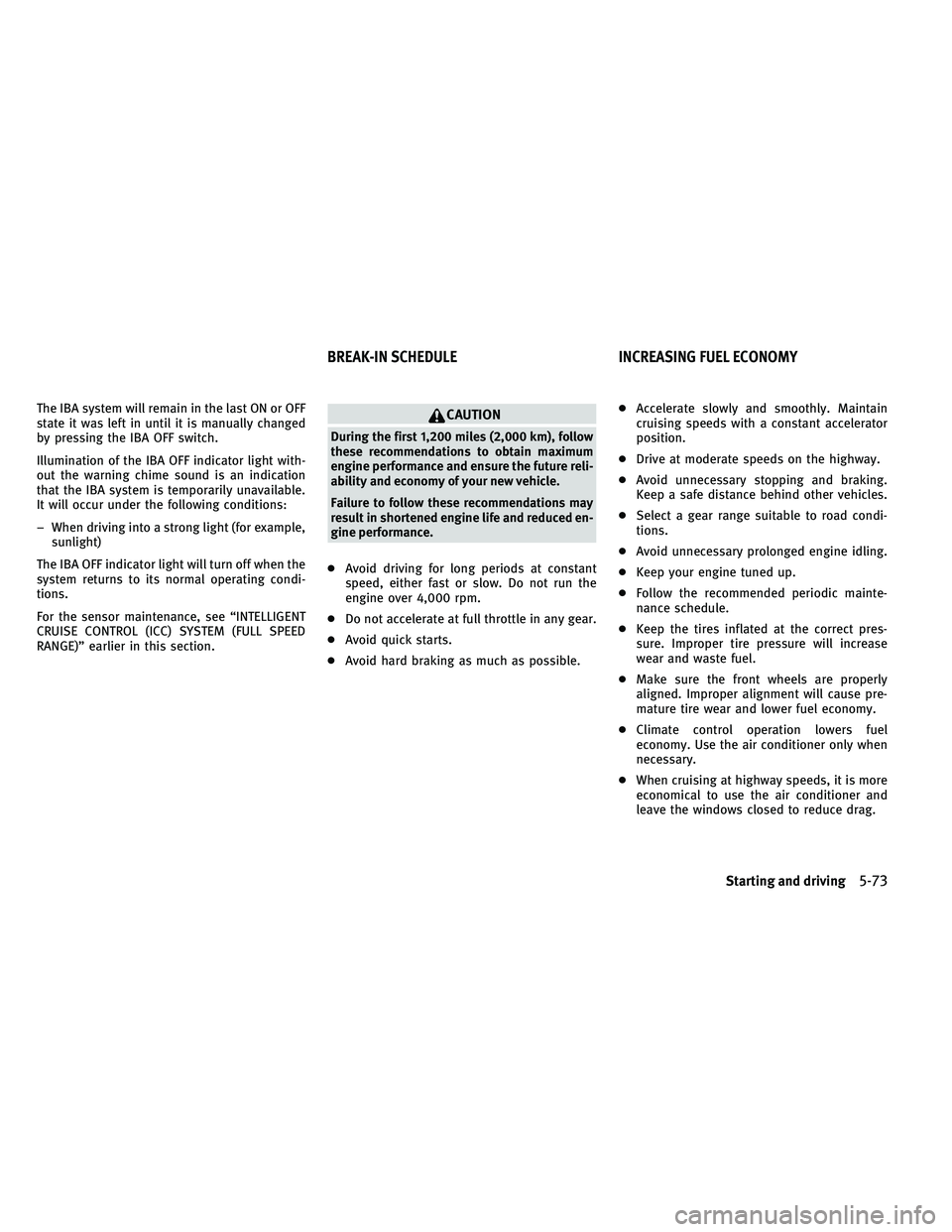
The IBA system will remain in the last ON or OFF
state it was left in until it is manually changed
by pressing the IBA OFF switch.
Illumination of the IBA OFF indicator light with-
out the warning chime sound is an indication
that the IBA system is temporarily unavailable.
It will occur under the following conditions:
– When driving into a strong light (for example,sunlight)
The IBA OFF indicator light will turn off when the
system returns to its normal operating condi-
tions.
For the sensor maintenance, see “INTELLIGENT
CRUISE CONTROL (ICC) SYSTEM (FULL SPEED
RANGE)” earlier in this section.CAUTION
During the first 1,200 miles (2,000 km), follow
these recommendations to obtain maximum
engine performance and ensure the future reli-
ability and economy of your new vehicle.
Failure to follow these recommendations may
result in shortened engine life and reduced en-
gine performance.
● Avoid driving for long periods at constant
speed, either fast or slow. Do not run the
engine over 4,000 rpm.
● Do not accelerate at full throttle in any gear.
● Avoid quick starts.
● Avoid hard braking as much as possible. ●
Accelerate slowly and smoothly. Maintain
cruising speeds with a constant accelerator
position.
● Drive at moderate speeds on the highway.
● Avoid unnecessary stopping and braking.
Keep a safe distance behind other vehicles.
● Select a gear range suitable to road condi-
tions.
● Avoid unnecessary prolonged engine idling.
● Keep your engine tuned up.
● Follow the recommended periodic mainte-
nance schedule.
● Keep the tires inflated at the correct pres-
sure. Improper tire pressure will increase
wear and waste fuel.
● Make sure the front wheels are properly
aligned. Improper alignment will cause pre-
mature tire wear and lower fuel economy.
● Climate control operation lowers fuel
economy. Use the air conditioner only when
necessary.
● When cruising at highway speeds, it is more
economical to use the air conditioner and
leave the windows closed to reduce drag.
BREAK-IN SCHEDULE INCREASING FUEL ECONOMY
Starting and driving5-73
Page 375 of 480
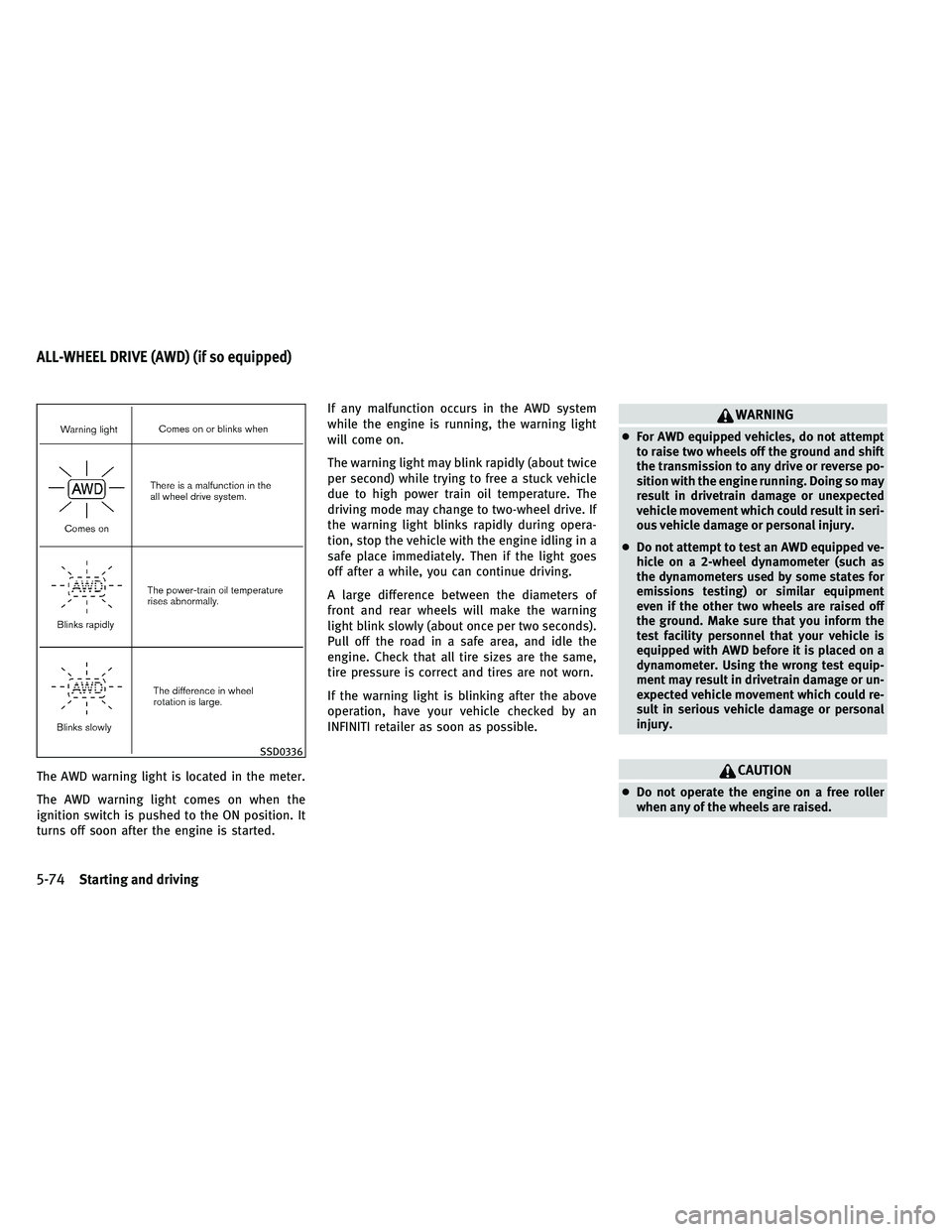
The AWD warning light is located in the meter.
The AWD warning light comes on when the
ignition switch is pushed to the ON position. It
turns off soon after the engine is started.If any malfunction occurs in the AWD system
while the engine is running, the warning light
will come on.
The warning light may blink rapidly (about twice
per second) while trying to free a stuck vehicle
due to high power train oil temperature. The
driving mode may change to two-wheel drive. If
the warning light blinks rapidly during opera-
tion, stop the vehicle with the engine idling in a
safe place immediately. Then if the light goes
off after a while, you can continue driving.
A large difference between the diameters of
front and rear wheels will make the warning
light blink slowly (about once per two seconds).
Pull off the road in a safe area, and idle the
engine. Check that all tire sizes are the same,
tire pressure is correct and tires are not worn.
If the warning light is blinking after the above
operation, have your vehicle checked by an
INFINITI retailer as soon as possible.
WARNING
●
For AWD equipped vehicles, do not attempt
to raise two wheels off the ground and shift
the transmission to any drive or reverse po-
sition with the engine running. Doing so may
result in drivetrain damage or unexpected
vehicle movement which could result in seri-
ous vehicle damage or personal injury.
● Do not attempt to test an AWD equipped ve-
hicle on a 2-wheel dynamometer (such as
the dynamometers used by some states for
emissions testing) or similar equipment
even if the other two wheels are raised off
the ground. Make sure that you inform the
test facility personnel that your vehicle is
equipped with AWD before it is placed on a
dynamometer. Using the wrong test equip-
ment may result in drivetrain damage or un-
expected vehicle movement which could re-
sult in serious vehicle damage or personal
injury.
CAUTION
● Do not operate the engine on a free roller
when any of the wheels are raised.
SSD0336
ALL-WHEEL DRIVE (AWD) (if so equipped)
5-74Starting and driving
Page 376 of 480
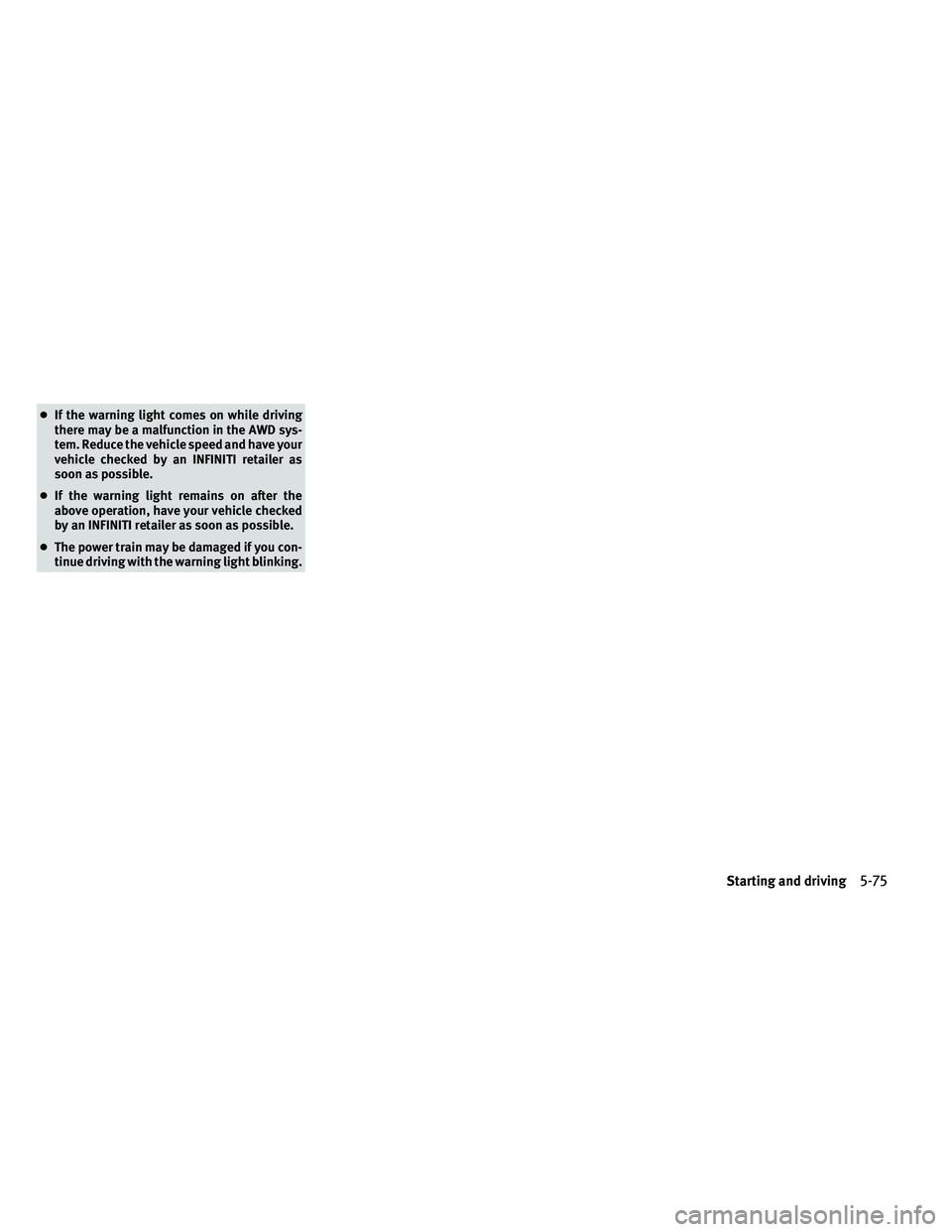
●If the warning light comes on while driving
there may be a malfunction in the AWD sys-
tem. Reduce the vehicle speed and have your
vehicle checked by an INFINITI retailer as
soon as possible.
● If the warning light remains on after the
above operation, have your vehicle checked
by an INFINITI retailer as soon as possible.
● The power train may be damaged if you con-
tinue driving with the warning light blinking.
Starting and driving5-75
Page 378 of 480

WARNING
If the engine is not running or is turned off while
driving, the power assist for the steering will
not work. Steering will be harder to operate.
The power assisted steering uses a hydraulic
pump, driven by the engine, to assist steering.
If the engine stops or the drive belt breaks, you
will still have control of the vehicle. However,
much greater steering effort is needed, espe-
cially in sharp turns and at low speeds.
BRAKING PRECAUTIONS
The brake system has two separate hydraulic
circuits. If one circuit malfunctions, you will still
have braking at two wheels.
You may feel a small click and hear a sound
when the brake pedal is fully depressed slowly.
This is not a malfunction and indicates that the
brake assist mechanism is operating properly.
Vacuum assisted brakes
The brake booster aids braking by using engine
vacuum. If the engine stops, you can stop the
vehicle by depressing the brake pedal. How-
ever, greater foot pressure on the brake pedal
will be required to stop the vehicle and the
stopping distance will be longer.
When the brake pedal is depressed slowly and
firmly, you may hear a clicking noise and feel a
slight pulsation. This is normal and indicates
that the Brake Assist System is operating.
Wet brakes
When the vehicle is washed or driven through
water, the brakes may get wet. As a result, your
braking distance will be longer and the vehicle
may pull to one side during braking.
To dry brakes, drive the vehicle at a safe speed
while lightly tapping the brake pedal to heat-up the brakes. Do this until the brakes return to
normal. Avoid driving the vehicle at high speeds
until the brakes function correctly.
PARKING BRAKE BREAK-IN
Break in the parking brake shoes whenever the
stopping effect of the parking brake is weak-
ened or whenever the parking brake shoes
and/or drums/rotors are replaced, in order to
assure the best braking performance.
This procedure is described in the vehicle ser-
vice manual and can be performed by an
INFINITI retailer.
Using the brakes
Avoid resting your foot on the brake pedal while
driving. This will cause overheating of the
brakes, wearing out the brake and pads faster
and reduce gas mileage.
To help save the brakes and to prevent the
brakes from overheating, reduce speed and
downshift to a lower gear before going down a
slope or long grade. Overheated brakes may
reduce braking performance and could result in
loss of vehicle control.
POWER STEERING
BRAKE SYSTEM
Starting and driving5-77
Page 379 of 480
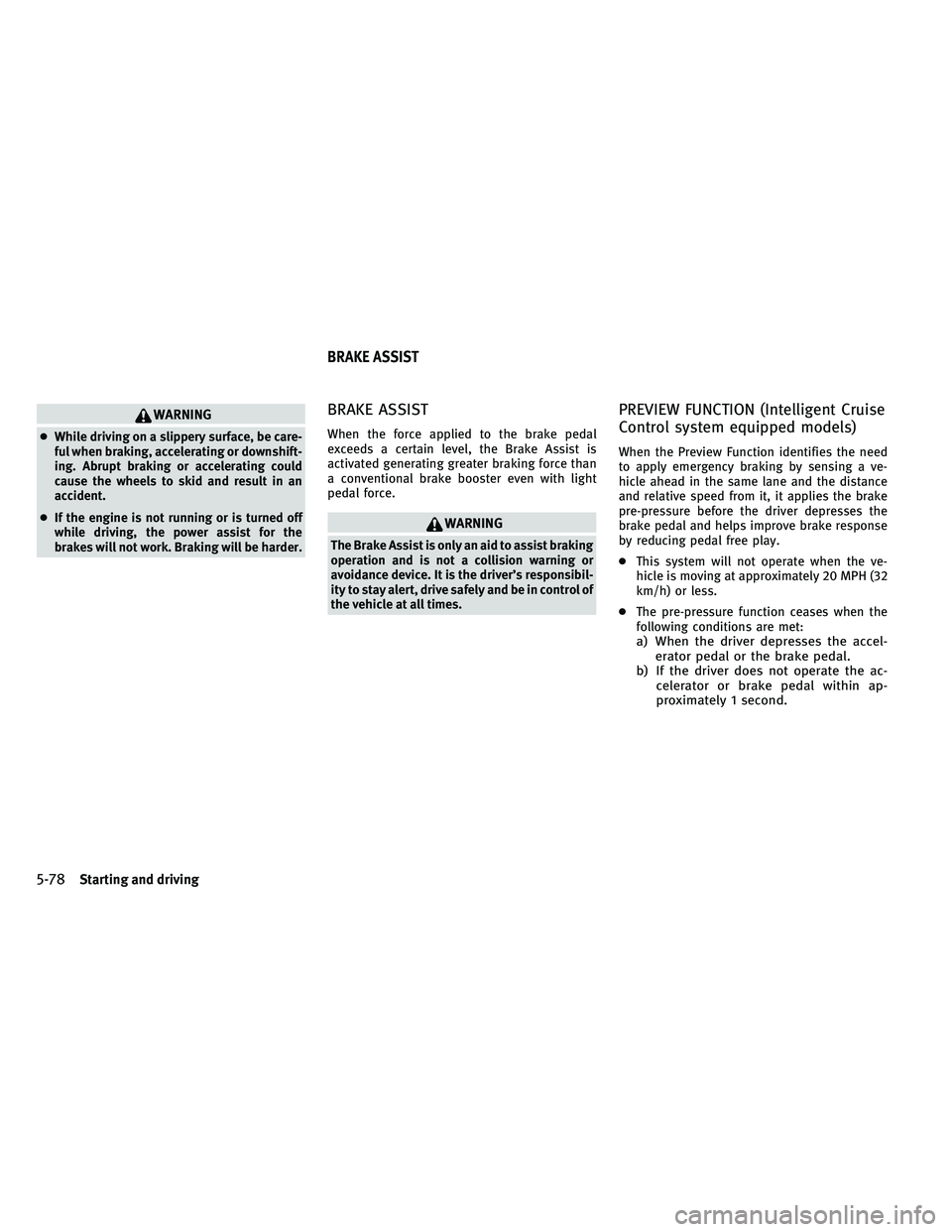
WARNING
●While driving on a slippery surface, be care-
ful when braking, accelerating or downshift-
ing. Abrupt braking or accelerating could
cause the wheels to skid and result in an
accident.
● If the engine is not running or is turned off
while driving, the power assist for the
brakes will not work. Braking will be harder.
BRAKE ASSIST
When the force applied to the brake pedal
exceeds a certain level, the Brake Assist is
activated generating greater braking force than
a conventional brake booster even with light
pedal force.
WARNING
The Brake Assist is only an aid to assist braking
operation and is not a collision warning or
avoidance device. It is the driver’s responsibil-
ity to stay alert, drive safely and be in control of
the vehicle at all times.
PREVIEW FUNCTION (Intelligent Cruise
Control system equipped models)
When the Preview Function identifies the need
to apply emergency braking by sensing a ve-
hicle ahead in the same lane and the distance
and relative speed from it, it applies the brake
pre-pressure before the driver depresses the
brake pedal and helps improve brake response
by reducing pedal free play.
● This system will not operate when the ve-
hicle is moving at approximately 20 MPH (32
km/h) or less.
● The pre-pressure function ceases when the
following conditions are met:
a) When the driver depresses the accel- erator pedal or the brake pedal.
b) If the driver does not operate the ac- celerator or brake pedal within ap-
proximately 1 second.
BRAKE ASSIST
5-78Starting and driving
Page 380 of 480

●The sensor will not detect:
a) Pedestrians or objects in the roadway
b) Oncoming vehicles in the same lane
c) Motorcycles traveling offset in the travel lane as illustrated
WARNING
●This system is only an aid to assist braking
operation and is not a collision warning or
avoidance device. It is the driver’s responsi-
bility to stay alert, drive safely and be in
control of the vehicle at all times. ●
As there is a performance limit to the Pre-
view Function, never rely solely on this sys-
tem. This system does not correct careless
inattentive or absent-minded driving, or
overcome poor visibility in rain, fog, or other
bad weather. Reduce vehicle speed by de-
pressing the brake pedal, in order to main-
tain a safe distance between vehicles.
● The system may not detect the vehicle in
front of you in certain road or weather condi-
tions. The Preview Function may not operate
properly under the following conditions. The
vehicle is still driveable under normal condi-
tions and the Brake Assist will operate.
– When rain, snow or dirt adhere to the sys- tem sensor
– When strong light (for example, at sun- rise or sunset) is directly shining on the
front of the vehicle
– Winding or hilly roads may cause the sen- sor to temporarily not detect a vehicle in
the same lane or may detect objects or
vehicles in other lanes.
– Vehicle position in the lane may cause the sensor to temporarily not detect a vehicle
in the same lane or may detect objects or
vehicles in other lanes. ●
When the Preview Function operates, the
brake pedal may move slightly and may
make a small noise. This is not a system
malfunction.
SSD0338
Starting and driving5-79
Page 381 of 480
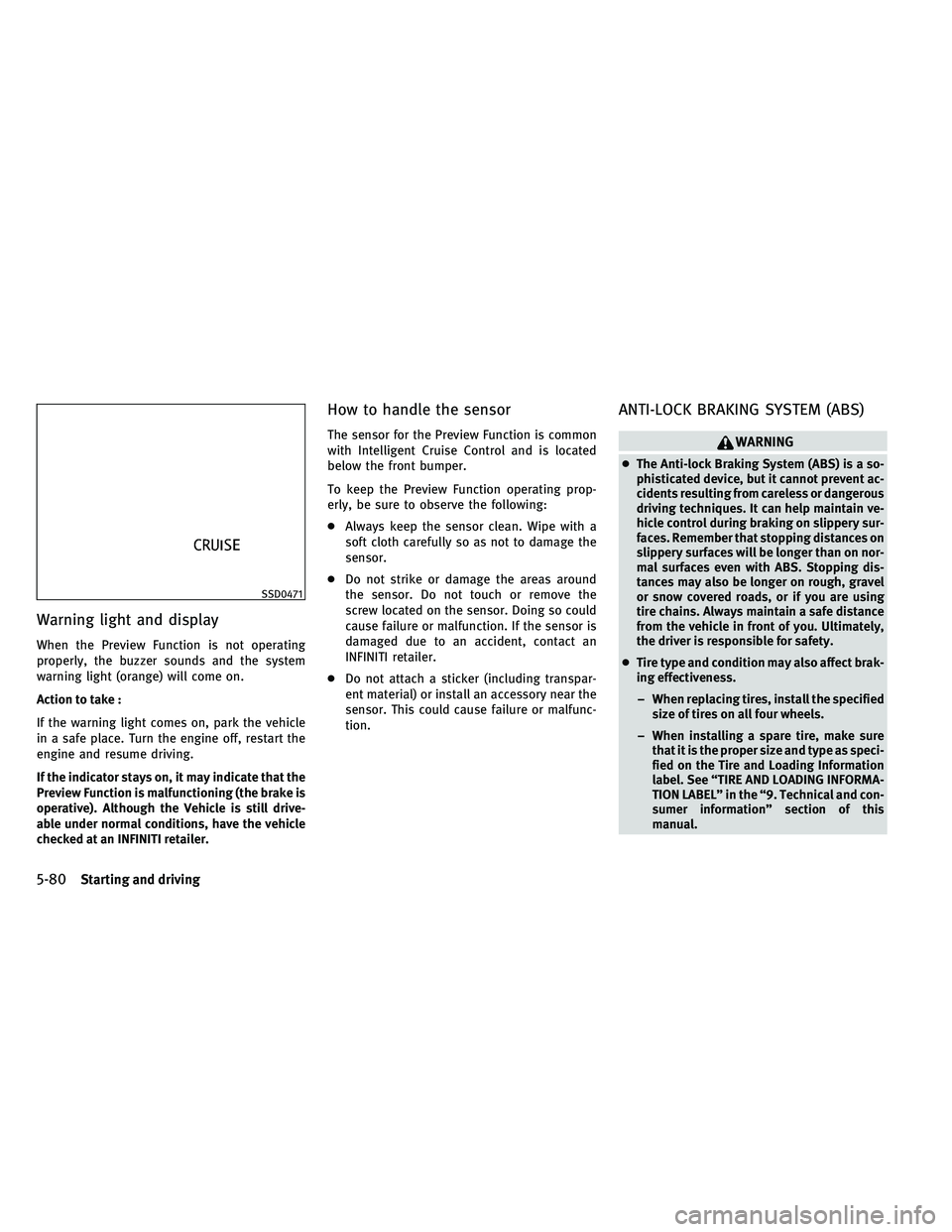
Warning light and display
When the Preview Function is not operating
properly, the buzzer sounds and the system
warning light (orange) will come on.
Action to take :
If the warning light comes on, park the vehicle
in a safe place. Turn the engine off, restart the
engine and resume driving.
If the indicator stays on, it may indicate that the
Preview Function is malfunctioning (the brake is
operative). Although the Vehicle is still drive-
able under normal conditions, have the vehicle
checked at an INFINITI retailer.
How to handle the sensor
The sensor for the Preview Function is common
with Intelligent Cruise Control and is located
below the front bumper.
To keep the Preview Function operating prop-
erly, be sure to observe the following:
●Always keep the sensor clean. Wipe with a
soft cloth carefully so as not to damage the
sensor.
● Do not strike or damage the areas around
the sensor. Do not touch or remove the
screw located on the sensor. Doing so could
cause failure or malfunction. If the sensor is
damaged due to an accident, contact an
INFINITI retailer.
● Do not attach a sticker (including transpar-
ent material) or install an accessory near the
sensor. This could cause failure or malfunc-
tion.
ANTI-LOCK BRAKING SYSTEM (ABS)
WARNING
● The Anti-lock Braking System (ABS) is a so-
phisticated device, but it cannot prevent ac-
cidents resulting from careless or dangerous
driving techniques. It can help maintain ve-
hicle control during braking on slippery sur-
faces. Remember that stopping distances on
slippery surfaces will be longer than on nor-
mal surfaces even with ABS. Stopping dis-
tances may also be longer on rough, gravel
or snow covered roads, or if you are using
tire chains. Always maintain a safe distance
from the vehicle in front of you. Ultimately,
the driver is responsible for safety.
● Tire type and condition may also affect brak-
ing effectiveness.
– When replacing tires, install the specified size of tires on all four wheels.
– When installing a spare tire, make sure that it is the proper size and type as speci-
fied on the Tire and Loading Information
label. See “TIRE AND LOADING INFORMA-
TION LABEL” in the “9. Technical and con-
sumer information” section of this
manual.
SSD0471
5-80Starting and driving
Page 382 of 480

– For detailed information, see “WHEELSAND TIRES” in the “8. Maintenance and
do-it-yourself” section of this manual.
The Anti-lock Braking System (ABS) controls the
brakes so the wheels do not lock during hard
braking or when braking on slippery surfaces.
The system detects the rotation speed at each
wheel and varies the brake fluid pressure to
prevent each wheel from locking and sliding. By
preventing each wheel from locking, the system
helps the driver maintain steering control and
helps to minimize swerving and spinning on
slippery surfaces.
Using the system
Depress the brake pedal and hold it down.
Depress the brake pedal with firm steady pres-
sure, but do not pump the brakes. The ABS will
operate to prevent the wheels from locking up.
Steer the vehicle to avoid obstacles.
WARNING
Do not pump the brake pedal. Doing so may
result in increased stopping distances.
Self-test feature
The ABS includes electronic sensors, electric
pumps, hydraulic solenoids and a computer.
The computer has a built-in diagnostic feature
that tests the system each time you start the
engine and move the vehicle at a low speed in
forward or reverse. When the self-test occurs,
you may hear a “clunk” noise and/or feel a
pulsation in the brake pedal. This is normal and
does not indicate a malfunction. If the computer
senses a malfunction, it switches the ABS off
and illuminates the ABS warning light on the
instrument panel. The brake system then oper-
ates normally, but without anti-lock assistance.
If the ABS warning light illuminates during the
self-test or while driving, have the vehicle
checked by an INFINITI retailer.
Normal operation
The ABS operates at speeds above 3 to 6 MPH
(5 to 10 km/h). The speed varies according to
road conditions.
When the ABS senses that one or more wheels
are close to locking up, the actuator rapidly
applies and releases hydraulic pressure. This
action is similar to pumping the brakes very
quickly. You may feel a pulsation in the brake
pedal and hear a noise from under the hood or
feel a vibration from the actuator when it is
operating. This is normal and indicates that the
ABS is operating properly. However, the pulsa-
tion may indicate that road conditions are haz-
ardous and extra care is required while driving.
Starting and driving5-81
Page 383 of 480
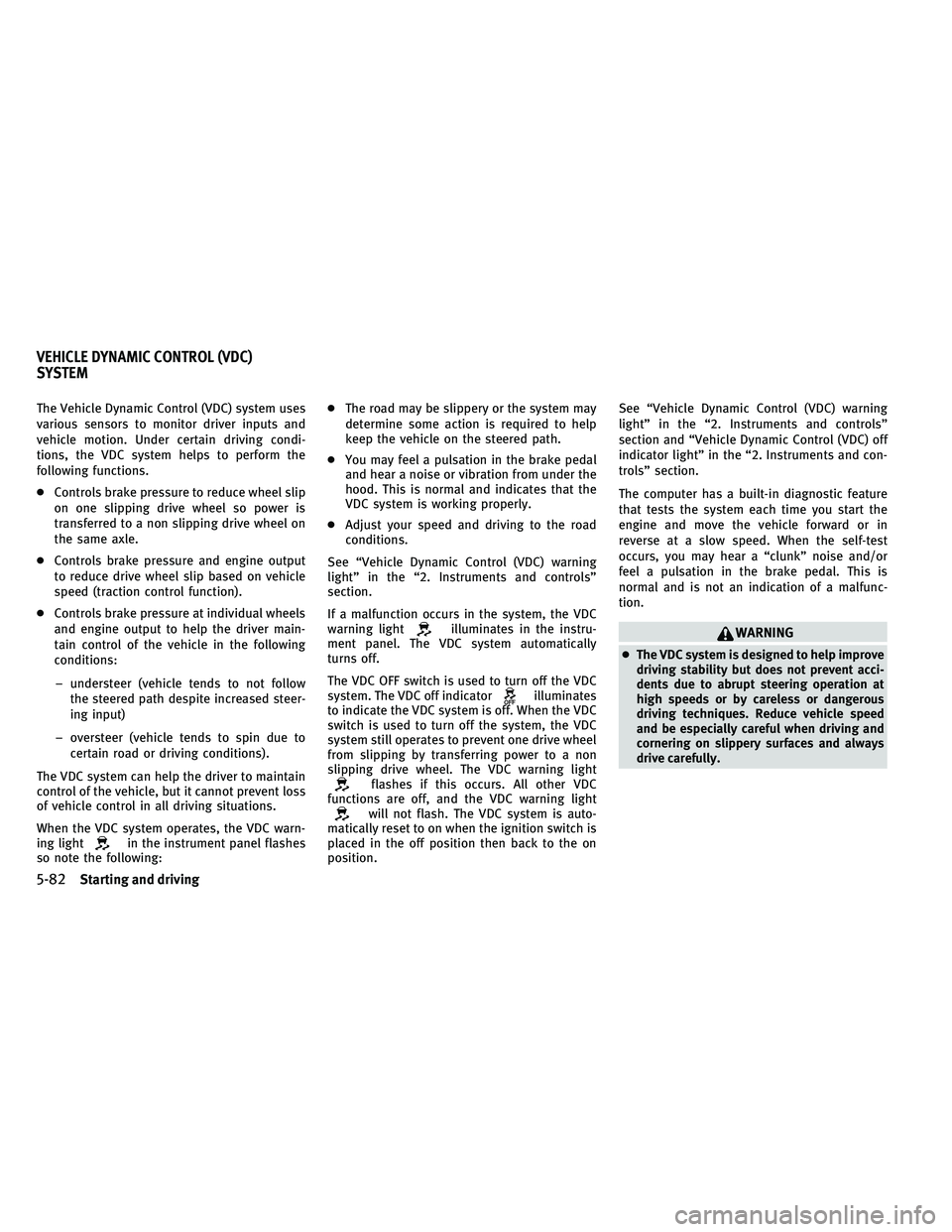
The Vehicle Dynamic Control (VDC) system uses
various sensors to monitor driver inputs and
vehicle motion. Under certain driving condi-
tions, the VDC system helps to perform the
following functions.
●Controls brake pressure to reduce wheel slip
on one slipping drive wheel so power is
transferred to a non slipping drive wheel on
the same axle.
● Controls brake pressure and engine output
to reduce drive wheel slip based on vehicle
speed (traction control function).
● Controls brake pressure at individual wheels
and engine output to help the driver main-
tain control of the vehicle in the following
conditions:
– understeer (vehicle tends to not follow the steered path despite increased steer-
ing input)
– oversteer (vehicle tends to spin due to certain road or driving conditions).
The VDC system can help the driver to maintain
control of the vehicle, but it cannot prevent loss
of vehicle control in all driving situations.
When the VDC system operates, the VDC warn-
ing light
in the instrument panel flashes
so note the following: ●
The road may be slippery or the system may
determine some action is required to help
keep the vehicle on the steered path.
● You may feel a pulsation in the brake pedal
and hear a noise or vibration from under the
hood. This is normal and indicates that the
VDC system is working properly.
● Adjust your speed and driving to the road
conditions.
See “Vehicle Dynamic Control (VDC) warning
light” in the “2. Instruments and controls”
section.
If a malfunction occurs in the system, the VDC
warning light
illuminates in the instru-
ment panel. The VDC system automatically
turns off.
The VDC OFF switch is used to turn off the VDC
system. The VDC off indicator
illuminates
to indicate the VDC system is off. When the VDC
switch is used to turn off the system, the VDC
system still operates to prevent one drive wheel
from slipping by transferring power to a non
slipping drive wheel. The VDC warning light
flashes if this occurs. All other VDC
functions are off, and the VDC warning light
will not flash. The VDC system is auto-
matically reset to on when the ignition switch is
placed in the off position then back to the on
position. See “Vehicle Dynamic Control (VDC) warning
light” in the “2. Instruments and controls”
section and “Vehicle Dynamic Control (VDC) off
indicator light” in the “2. Instruments and con-
trols” section.
The computer has a built-in diagnostic feature
that tests the system each time you start the
engine and move the vehicle forward or in
reverse at a slow speed. When the self-test
occurs, you may hear a “clunk” noise and/or
feel a pulsation in the brake pedal. This is
normal and is not an indication of a malfunc-
tion.
WARNING
●
The VDC system is designed to help improve
driving stability but does not prevent acci-
dents due to abrupt steering operation at
high speeds or by careless or dangerous
driving techniques. Reduce vehicle speed
and be especially careful when driving and
cornering on slippery surfaces and always
drive carefully.
VEHICLE DYNAMIC CONTROL (VDC)
SYSTEM
5-82Starting and driving
Page 384 of 480
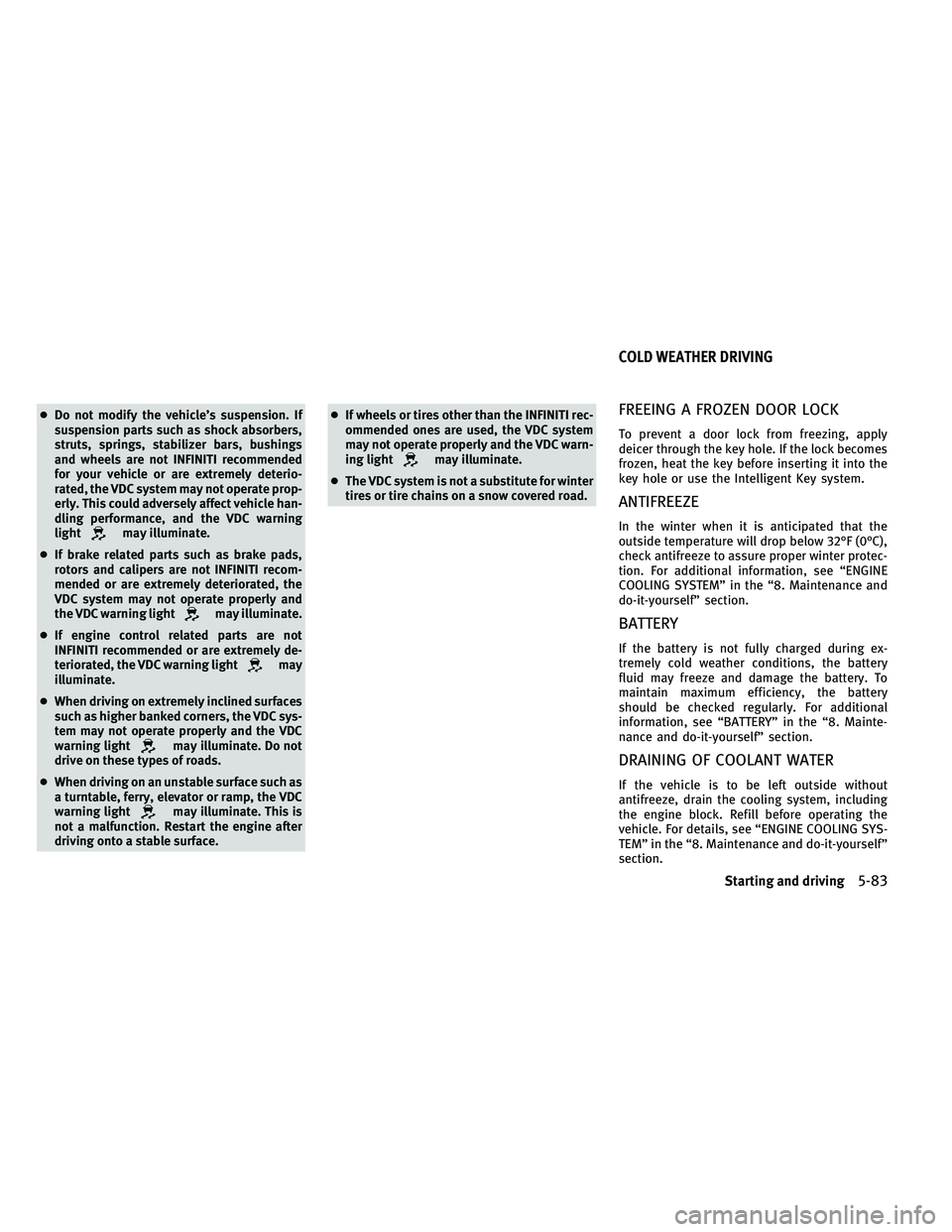
●Do not modify the vehicle’s suspension. If
suspension parts such as shock absorbers,
struts, springs, stabilizer bars, bushings
and wheels are not INFINITI recommended
for your vehicle or are extremely deterio-
rated, the VDC system may not operate prop-
erly. This could adversely affect vehicle han-
dling performance, and the VDC warning
light
may illuminate.
● If brake related parts such as brake pads,
rotors and calipers are not INFINITI recom-
mended or are extremely deteriorated, the
VDC system may not operate properly and
the VDC warning light
may illuminate.
● If engine control related parts are not
INFINITI recommended or are extremely de-
teriorated, the VDC warning light
may
illuminate.
● When driving on extremely inclined surfaces
such as higher banked corners, the VDC sys-
tem may not operate properly and the VDC
warning light
may illuminate. Do not
drive on these types of roads.
● When driving on an unstable surface such as
a turntable, ferry, elevator or ramp, the VDC
warning light
may illuminate. This is
not a malfunction. Restart the engine after
driving onto a stable surface. ●
If wheels or tires other than the INFINITI rec-
ommended ones are used, the VDC system
may not operate properly and the VDC warn-
ing light
may illuminate.
● The VDC system is not a substitute for winter
tires or tire chains on a snow covered road.
FREEING A FROZEN DOOR LOCK
To prevent a door lock from freezing, apply
deicer through the key hole. If the lock becomes
frozen, heat the key before inserting it into the
key hole or use the Intelligent Key system.
ANTIFREEZE
In the winter when it is anticipated that the
outside temperature will drop below 32°F (0°C),
check antifreeze to assure proper winter protec-
tion. For additional information, see “ENGINE
COOLING SYSTEM” in the “8. Maintenance and
do-it-yourself” section.
BATTERY
If the battery is not fully charged during ex-
tremely cold weather conditions, the battery
fluid may freeze and damage the battery. To
maintain maximum efficiency, the battery
should be checked regularly. For additional
information, see “BATTERY” in the “8. Mainte-
nance and do-it-yourself” section.
DRAINING OF COOLANT WATER
If the vehicle is to be left outside without
antifreeze, drain the cooling system, including
the engine block. Refill before operating the
vehicle. For details, see “ENGINE COOLING SYS-
TEM” in the “8. Maintenance and do-it-yourself”
section.
COLD WEATHER DRIVING
Starting and driving5-83